
With the assistance and support of those around him, Michael Holdsworth began to turn his vision into reality. Dina Holdsworth, as chairman, supplied enthusiasm and encouragement.1
Trevor Marsden was appointed company secretary in 1978, having joined the firm as an office boy in 1956. He obtained his accountancy qualifications at night school in his own time and at his own expense during an era when the company regarded such things as an extravagance. He learned the ropes under a hard taskmaster, Walter Townend, and his financial expertise became a considerable asset to the firm. This was reflected in his appointment as financial director at the end of 1981.2
Raymond Sutcliffe retired as sales director in 1981. The board had little idea on who to appoint in his place and sought his advice. Raymond agreed to contact Ernest Hirsch, the sales director at one of Holdsworth's main rivals, Firth Fabrics, in Heckmondwike. It so happened that a new broom was sweeping clean at Firth's and Ernest had just received his redundancy notice. Over the course of a weekend, he became Holdsworth's new sales director.3
Ernest Hirsch's background was in design and he was insistent that Holdsworth's needed new designs to sell to customers. He was also an excellent salesman who had built up close personal relationships with customers all over the world. He too became an invaluable asset to the company.4
Michael had been joined in the business by his younger brother, David. It was only after graduating from university with a physics degree that David decided to enter the family firm. Like his brother, he took a further qualification in textiles, this time in Manchester, and began work at Shaw Lodge Mills in 1975. He too quickly reached the same conclusions as his brother. The shoestring approach he found counter-productive. For example, the company was paying a small fortune every year for coal yet David was not allowed to spend money on measures to prevent most of the steam generated from being lost. David Holdsworth was appointed general manager in 1981, becoming production director in 1983 to permit his brother to concentrate upon other aspects of the business.5
Less than three months after the retirement of Walter Townend, Michael Holdsworth brought a report to the board on the future of the spinning and weaving departments. The Spinning department existed to provide most of the yarn for the company's looms and managed to break even until the early 1970s. The age of the plant then began to show and the department slipped into a loss-making position. Such losses could not be sustained indefinitely. There were two options. The plant could be renewed at some cost to return the department to profit. Or the plant could be closed down and yarn bought in from outside suppliers.6
Neither option could be considered in isolation from the future of the weaving shed. This was the company's core operation. Michael had taken several senior members of staff, including Arthur Taylor, Fred Breaks, Derek Bradley and Peter Hepworth, to look at new looms at the international textile machinery exhibition, 'ITMA' in Milan. After reviewing the machines on offer in Milan and looking again at the three modern looms purchased by the company in the early 1970s, it was decided that the best loom for Holdsworth's purposes would be the Gusken shuttle-less rapier loom. Michael proposed that Holdsworth's should buy a dozen such looms. 7
The company could not afford to fund the re-equipping of both the spinning department and the weaving shed at the same time. The weaving shed had to take priority. In the autumn of 1979 John Holdsworth & Company therefore gave up worsted spinning after more than 150 years.
The loom renewal programme represented substantial capital expenditure for a firm like Holdsworth's which was still earning relatively low profits and carried with it the historical baggage of previous generations. The firm's accountant counselled that the company should purchase only one loom at a time! 8 It was at this point that the company moved banks. Lloyds and its predecessors had been the company's bankers since it had been founded. During the 1970s, however, as Holdsworth's export business had begun to grow, the firm had turned to Barclays to obtain a more efficient service in collecting overseas payments. As well as offering slightly better terms on the loan sought by the company, Barclays also impressed Holdsworth's with the level of confidence they placed in the future plans for the business.9
Nevertheless, the 12 looms had to be acquired in two phases between 1979-80. Things did not go as smoothly as anticipated. Michael Holdsworth recalled that 'It was really appalling, just horrible, a nightmare!'. He discovered that the whole shed would have to be re-wired to take the new looms. There was not a door wide enough to get the looms through so one had to be altered. The existing flagstone floors were completely unsuitable for precision-engineered looms and a railway line had to be built to transport them the length of the shed. At least the company had foreseen the need to lay down concrete bases for the looms and install girder-work for the Jacquards accompanying them.10
The nightmare was worth it. The first six looms enabled the company to raise production in one year by 22 per cent. 11 They enabled Holdsworth's to steal a march on their rivals and make an increased width of cloth suitable for the European market. The first dozen rapier looms formed the start of a replacement programme which saw Holdsworth's change every one of its 49 wire looms and 36 face-to-face looms within 2½ years, a critical element in the firm's progress towards market leadership.12
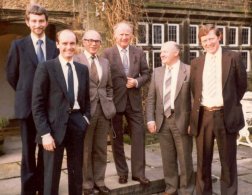 Rodney Hirst,
Michael Holdsworth,
Ernest Hirsch,
Rodney Hirst,
Michael Holdsworth,
Ernest Hirsch,It was at this point that Ernest Hirsch joined the board and the company began to develop its overseas sales with gusto. In 1979, the majority of the goods exported by Holdsworth's were sent to Scandinavia and Germany. Ernest Hirsch's contacts from his long career in the trade gave the company a kick-start in increasing its export business, particularly in North America and Australasia.
In April 1981 Michael Holdsworth and Ernest Hirsch made a well-received visit to the United States. Holdsworth's quickly received their first American orders and towards the end of the year the company appointed its first agent to cover the American market. The early success of this venture prompted the company to invest in a Gusken loom for the production of piece-dyed plain fabrics, the goods most favoured by American customers.13
The company did not see the appointment of an agent as the culmination of its efforts in North America. For too long, the message came back loud and clear, British exporters had been conspicuous by the lack of personal attention they had given to their customers. Ernest Hirsch was insistent that Holdsworth's would only be able to retain and grow its newly-found business by a combination of frequent personal visits from Halifax and an unrelenting emphasis upon service and quality. Whenever Holdsworth's American sales dipped, it was because rivals had been able to capitalise upon an apparent decline in the service and quality offered by the company.14
Sales in North America grew to form approximately a fifth of the company's turnover. The importance of this market led to the formation of an American subsidiary, Holdsworth North America Inc, which began trading in September 1994. The subsidiary has established an office and warehouse with two representatives in Indianapolis to cement the close relationships which have been developed with customers over the last decade.
Australasia was another major market built up from scratch. Based again upon existing contacts made by Ernest Hirsch, sales to Australia and New Zealand began to take off after Ernest had visited the area with Trevor Marsden in the summer of 1983. Further visits followed and by the end of 1985 32 of the 36 coaches shown at the Sydney Motor Show were trimmed with fabric produced by Holdsworth's. 15
The company's export drive in Continental Europe, which continued to be Holdsworth's most important overseas market, was spearheaded by Peter Hepworth. After nearly a quarter of a century as the manager of the finishing department, Peter took over a new role as a sales representative in 1978. He decided that it was about time for the company to begin attending exhibitions in Europe. Putting a stand in the back of his car and travelling overnight by ferry, he erected the small stand himself and manned it with one of the company's designers. This persistence paid off and the reward came with a major order from Van Hool, an important Belgian coach-builder, the first of many. 16
Peter Hepworth promoted Holdsworth's moquette as the best in its field and he soon found customers agreeing with him. They bought Holdsworth moquette not on price but on the basis of its quality and design. With sales expenses fixed as a percentage of turnover, the more sales increased the greater opportunity the sales team had for improving the quality and scope of their marketing. Peter, often accompanied by his wife, Marion, began to travel all over Europe, including Belgium, Holland, Spain, Portugal, Hungary, Slovenia, Italy, Turkey and Greece. In Piraeus, he attended a shipping exhibition to promote the use of Holdsworth moquette to ferry operators, a new departure for the company. 17
Scandinavia, where Holdsworth's moquette export business had begun in the 1930s, still formed a significant part of its European business and Michael Holdsworth continued to make regular visits there.
The success achieved by Holdsworth's in these markets provided the company with a platform from which to penetrate markets in other countries all over the world, in the Middle East, the Far East, South Africa, South America, Cyprus and Russia. In almost all of these countries, including the United States, John Holdsworth & Company became the market leader. All these overseas markets combined now make up three-quarters of the company's sales, a considerable export achievement.
Although the company outgrew the UK market, this still forms a quarter of all sales, thanks to the same emphasis upon quality, service and personal attention. The UK-based business consists of three field sales representatives and an administrative support team at Shaw Lodge Mills. Overseas sales are also conducted through a network of representatives or agents.
Good communications proved to be the key to cementing relationships not only with customers but also internally between sales, design and production. It was important that the message about the importance of quality got through to all levels within the company.
As the recently appointed production director, David Holdsworth had a key role to play in this respect. The steady flow of unremunerative, low-price work on contract for British Rail and London Transport had until that time been regarded as 'loom fodder' to keep the looms busy. This led to an emphasis upon volume rather than quality. The latter suffered as material accumulated to be mended and repaired before it could be sent out. 18
The combination of new looms, new production management and an emphasis on absolute quality completely transformed this situation to ensure that customers continued to receive as a matter of course the standard of cloth from the company they had come to expect. A trade journalist could report in 1985 that 'moquettes produced by the company undergo wear and colour tests, have to be finished to perfection, are designed either to suit individual requirements or to suit a particular interior or colour scheme, have to repel dirt and stains and must remain soft enough to mould to contours and corners of seat frames and padding. Holdsworth have turned production into an art'. The article continued that 'Whatever the fault, Holdsworth's inspectors will not pass the cloth unless it is perfect.' 19
On top of this improvement in quality, the company, through its capital investment programme, managed at the same time to increase output. New looms and new production techniques saw the volume of cloth woven rise from some 9,000 metres to well over 30,000 metres a week between 1979 and 1999.
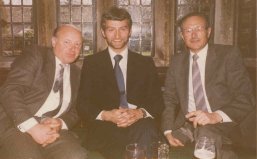 Irwin Winterberg, Rodney Hirst, Hermann Caspers.
Irwin Winterberg, Rodney Hirst, Hermann Caspers.For Ernest Hirsch, the company's designers were an integral part of the sales team: 'Without the designers we couldn't be where we are'. 20 The head of the design department in 1979 was Albert Wood, whose predecessors over the former 20 years had been Jack Thompson and Isaac Jennings. Albert died suddenly on Christmas Day in 1980 and his place was taken by Rodney Hirst. When Rodney left the firm in 1987 (only to return three years later), David Hallgarth took over the role.
For many years the design process involved painting an appropriate design of the right quality on slate paper (point-paper) which was then passed on to the jacquard card cutting department. A sample was woven and sent out to the customer. There was little customer participation in the process. During this period of time Holdsworth's produced a new range of bus and coach designs every two years and salesmen took samples around the trade in the UK.
Things began to change in the 1980s. Instead of accepting what was offered to them, customers began to insist on putting forward their own ideas and becoming actively involved in drawing up designs. Partly as a result of this involvement and partly because of the greater importance placed upon marketing by the company, Holdsworth's produced a wider range of more varied and colourful designs, for example, often using double-twisted yarn where two threads of differing colours are combined to provide a more striking background. The adoption of yarn-dyed fabric also made possible a greater variety of patterns. Perhaps the most remarkable change since 1979 has been in the number of colours available for individual designs. With increasing customer involvement and a precise specification for particular colours, this has soared from 17 to more than 400.21
There was greater pressure from customers for speedier delivery and this was made easier to accomplish when computer-aided design technology (CAD) was first introduced in the late 1980s.22 Today a designer can create on the computer three-dimensional images showing any number of designs as they would appear within a bus, coach or other interior. Samples can be printed with the appearance of a woven texture, enabling the firm to weave only samples of those designs preferred by the customer.
Computerisation was first introduced to the company in 1979 by David Holdsworth to perform routine administrative tasks in the weaving office, such as wages and production calculations, and an added bonus of this was the complex cost analysis of the proposed investment in new looms. In 1984 computer technology was established throughout the company, with a small network of personal computers (PCs) and a multi-user business system. Ten years later this had expanded to include a wide area fibre-optic data network with 80 individual personal computer stations, and shop-floor data collection points which tracked the location, route and processing of every item in the factory, all maintained by an information technology department of three individuals. Computers were also employed to monitor and control all building and environmental services, including electricity, natural gas, mains water, steam, compressed air, lighting, security systems and the heating system for the mills. Increasingly the Internet became the medium for external communications, and rapid transfer of designs with customers and suppliers. As computer and communications technology continued to develops at ever increasing rates, the investment in this area continued to take advantage of the increased speed and funcionality available, resulting in a dramatic reduction in the amount of paper-based administration being produced. Information could be presented on demand, with accurate and up to date 'live' summaries.23
The installation of new heating and steam generation systems was part of the third strand of the company's investment programme. In 1977 the three coal-fired Lancashire steam boilers had been replaced by a new 10,000 Lb/hour automated coal-fired package boiler. Within three years energy reduction measures had driven down the steam demand by two thirds, and a 2,000 Lb/hour oil-fired boiler was installed to cater for process steam. It was not until 1994 that the boiler-house was completely shut down, when steam generators were installed close to the points of use for processes and all the steam-fed space heating had finally been replaced with natural gas. The project reduced energy and labour costs, had a huge positive environmental impact, and paid for itself within two years.
The refurbishment of Shaw Lodge Mills began in the mid-1980s, just as Holdsworth's sales drive was getting into its stride. It began when the mill roof was sprayed with a foam mixture designed to seal and insulate it. As Michael Holdsworth recalled, 'We had a lot to change. The whole infrastructure of the company was bad. It had been completely run down. Nothing had been spent. We were spending on building, on heating, on lighting, on electricity. The floors weren't strong enough so we had to strengthen them. The buildings we either pulled down or we tried to patch up'. The first building to be completely overhauled was 'D' shed, the former combing shed, in 1986. The looms were removed, the building re-roofed and refurbished, and the looms re-installed. Since that date, Holdsworth's have overhauled all the main multi-storey buildings, the clock tower, the offices and half of the weaving shed at a cost approaching a million pounds. The next phase of the refurbishment programme was planned for the weaving shed.24
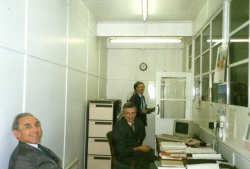 Fred Breaks, weaving manager;
Fred Breaks, weaving manager; All this progress was not achieved easily or painlessly. Many of the issues were talked through, argued about, fought over and decided not around the boardroom table but around the desk in Michael Holdsworth's office late at night. It was an exhilarating experience but for everyone involved throughout the company it was hard work.
The increase in the company's overseas business made it less vulnerable to the fluctuations in the British economy but more susceptible to the ups and downs of the exchange rate. Just as the company was seeking to expand its export sales in the early 1980s, the rise in the value of sterling made additional business harder to find. In Germany, for example, customers found it cheaper to buy from Continental manufacturers. In response the company had to adopt a flexible pricing policy to retain goodwill and keep out competition.25 The possibility of an over-valued pound has remained the most likely deterrent to the continuing expansion of the company's sales overseas although the company's operation in so many different countries should minimise the extent of the risk involved.
Most of the company's competition has come from smaller businesses producing imitation products at a lower price. Towards the end of 1990, for example, an American magazine, in profiling Holdsworth's, noted that copies of the company's fabrics had begun to appear: 'While that mimicry represents something of a back-handed compliment, it can prove misleading to a buyer. Some companies manufacture not in wool but in man-made fibres, either in the United States or across the border in Mexico. That enables them to lower their prices while passing off their fabrics as "Holdsworth-style" fabrics'.26
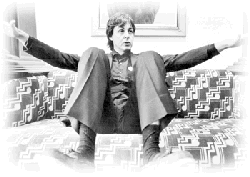 Paul McCartney on Holdsworth moquette
Paul McCartney on Holdsworth moquette
By that time, the company's turnover had risen to a record level. Compared with sales in 1979, this represented an increase in real terms of some 130 per cent in ten years. Even more dramatic was the improvement in profitability. Net profits had trebled in real terms, representing a return on sales of more than five per cent. Then came the onset of recession not only in Britain but throughout the rest of the world. Holdsworth's turnover dropped over the next two years. Holdsworth's other rivals in UK and Ireland suffered similarly from the recession. This prompted one of them, Firth Fabrics, to make an offer for Holdsworth's on the grounds that combining the two turnovers would make one viable business. Michael Holdsworth rejected this overture: 'I know that business is meant to make money and money is meant to be a God. In this business, it isn't. It is a by-product of keeping the business going. Of course, if we don't make money, the business will collapse so it is a very important by-product but it isn't the only goal. Whereas with public companies, their only goal is profit or returns to the shareholders so they can't be as long-term as we can'.27
Instead Michael persuaded Firth's to sell to Holdsworth's the moquette side of their diverse business, the mainstay of which was carpets. This deal, however, was considerably delayed because of a referral to the Monopolies & Mergers Commission since it would give Holdsworth's the lion's share of the UK market if it went ahead.
At the same time, another rival, the Irish business of Max Birr Ltd, went into receivership. Uncertain whether or not the Firth's deal would proceed, Holdsworth's decided to make to the receiver a bid for Birr's business. The bid of was accepted and on 19 December 1991 Holdsworth's took over the business, renaming it Shannon Velours Ltd.
Two weeks later, the company was given consent to purchase Firth's bus and coach division. On 10 January 1992 Holdsworth's paid for the business. This placed Holdsworth's in a slightly difficult situation. Firth's wanted Holdsworth's to take over all their machinery within six months. There was also machinery in Ireland. The company had insufficient space at Shaw Lodge Mills. Instead, Holdsworth's sought to keep the Irish company going and use available space in Ireland as a machinery store for equipment acquired from Firth's.
The Irish company never went into production and was wound up in 1993. Nevertheless, the deal proved profitable for Holdsworth's. Birr's factory site was sold; the company shipped a number of wire looms to Halifax, and, most importantly, Holdsworth's retained Birr's significant customers. The purchase of Firth's bus and coach business was even more successful. Holdsworth's was able to sell a modern finishing line taken over from Firth's. The customer accounts inherited from Firth's made a significant impact to the volume of business at Holdsworth's during 1992.
Since then the company has taken further strides forward. By the end of 1994, most of the debt incurred to finance the Birr and Firth Fabrics purchases had been repaid. Sales stood at record levels. The company was able to recommence its capital investment programme and steal a further march upon its rivals through the acquisition of 12 face-to-face looms with state-of-the-art electronic jacquards. These completely computerised looms, operated twice as fast as the machines they replaced. Increased profitability enabled the firm to raise salaries and keep wages in line with union rates.28
A further 12 similar looms and electronic jacquards were installed in the period leading into the new millennium.
Halifax has changed since John Holdsworth began spinning worsted yarn at Waterside Mill in 1822. The town's largest employer is now Halifax plc, formerly the world's largest building society, recently converted into a bank, with more than 3,500 employees, three and a half times more than the next largest private sector employer. At its peak in the mid-nineteenth century, John Holdsworth & Company employed nearly as many at Shaw Lodge Mills. But manufacturing remains important in Halifax, employing a third of the population compared with 18 per cent nationally. With some 350 employees, Holdsworth's still makes an important contribution locally.
The British wool textile industry has become a slender shadow of its former self, unable to compete in the face of cheap foreign competition. This too is reflected in Halifax where businesses which flourished under well-known names, such as the McCreas, the Akroyds and the Crossleys, no longer exist. Many of the mills erected in the nineteenth century have been demolished or stand sadly neglected although a number of them have found alternative uses, most notably Dean Clough. Carpet production ceased there in 1982 but the complex of buildings still forms the work-place for more than a thousand people in nearly 200 different businesses.
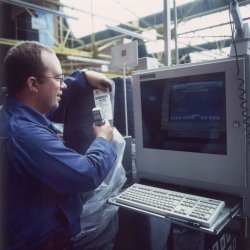 Tracking goods by radio frequency data collection, in
Tracking goods by radio frequency data collection, in Shaw Lodge Mills, by contrast, is an impressive testament to the survival and recent success of John Holdsworth & Company. A family business spanning 200 years and six generations operates a modern, competitive production process within the original mill buildings. This close physical relationship between the past and the present sums up the story of the business more tellingly than any words.
John Holdsworth & Company has outlived all its major rivals in Halifax and beaten off its present-day British competitors to become a world leader in its own market. The business was founded upon the entrepreneurial drive and vision of John Holdsworth and his sons. When the British textile industry was at its peak, the firm flourished as a fully integrated business under the direction of William Holdsworth and his brothers working together in partnership. As competition increased, the firm moved gradually towards specialisation, dispensed with wool combing and the production of yarn for sale, and concentrated upon its core activities. The company struggled for survival for most of the twentieth century, beset by a lack of direction from the family and a tendency on their part to live beyond their means. It was others from outside the family who worked to keep the business afloat through some very difficult years.
The sixth generation of the family has displayed the flair and spirit of the founder and his sons. It has also shown that the working partnership between several members of the same generation can still prove successful today. The revival and renaissance of the company has come about through a continuous three-pronged programme of investment in production, marketing and infrastructure. New technology has been embraced, exports have been promoted, and the mill buildings converted into a proper working environment for a modern-day business. But Michael Holdsworth and his fellow directors readily acknowledge that the company's greatest strength remains those who work for it at all levels. The company depends today, as it has in the past, upon the skill of those who produce and sell the fabric which so many others have tried and failed to replicate and whose success is demonstrated by the millions of people all over the world travelling in comfort while seated on Holdsworth moquette.
[Written in year 1999 DWH]
Postscript
In July 2005, the John Holdsworth business and property was sold to Hanson Partners of Bradford.
In October 2007, the business was bought by the Camira Group of Mirfield; the property remaining in the hands of
Hanson Partners.
Production continued until August 2008 at
Shaw Lodge Mills as
Hebble Valley Weavers.
It was intended that
Shaw Lodge Mills would be redeveloped and production would be moved to another site in Calderdale and eventually overseas to Eastern Europe or Asia.
In November 2007, the Evening Courier announced that the business may close in early 2008, with the loss of 160 jobs, unless costs were reduced and production was increased.
In February 2008, the Evening Courier announced that the firm would close with the loss of 146 jobs
To Be Continued
Cross references used in this chapter
Sources of Information used to prepare the John Holdsworth corporate history
|
©
2025
David W. Holdsworth |
|
Please send questions, updates, additions to: |